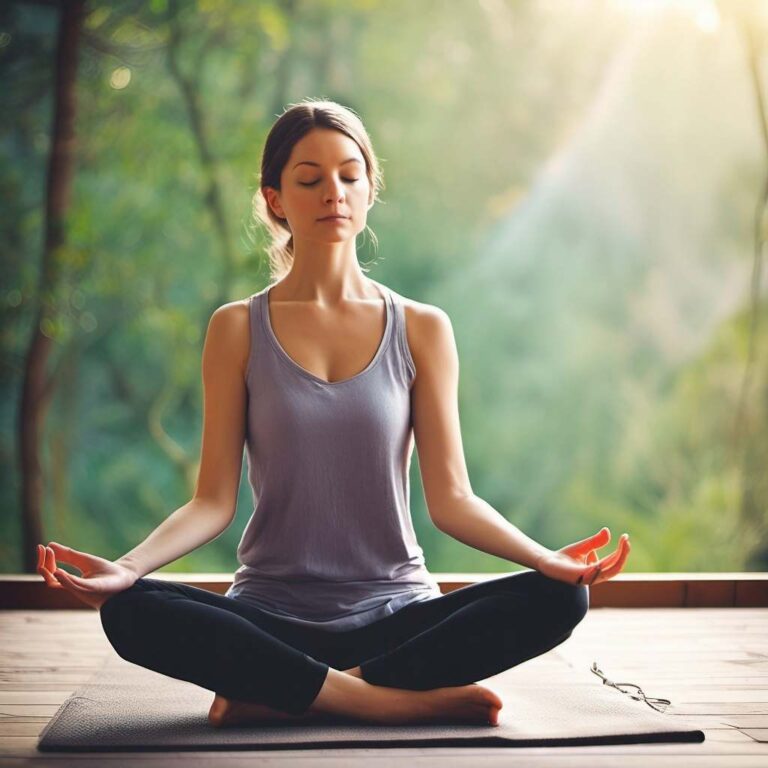Guided Meditation – Unlock Your Inner Peace in 2023
Feeling frazzled or overwhelmed lately? Rest assured, you are not alone. In fact, more than 14% of adults in the US have tried meditation at least once to combat such issues. This blog will unravel the art and science of guided meditation – a simple yet effective tool that can enhance your mental clarity, focus and overall well-being.
Let’s explore this transformative practice together!
Key Takeaways
- Guided meditation is a simple yet effective tool that can enhance mental clarity, focus, and overall well-being.
- It has numerous benefits, including reducing anxiety and stress, improving sleep quality, enhancing mindfulness and self-awareness, and promoting emotional healing and spiritual awakening.
- Different types of guided meditation include breathing exercises, body scan meditation, loving – kindness meditation, and visualizations.
- To practice guided meditation effectively, find a quiet space, choose a suitable guided meditation for your needs, set a timer for dedicated practice time. Focus on your breath and follow the guidance provided during the session.
Benefits of Guided Meditation
- Guided meditation reduces anxiety and stress, providing a sense of calmness and relaxation.
- It improves sleep quality, helping individuals achieve a more restful and rejuvenating night’s sleep.
- Guided meditation enhances mindfulness and self-awareness, allowing individuals to be present in the moment and cultivate a deeper understanding of themselves.
- It promotes emotional healing and spiritual awakening by providing an avenue for inner exploration and reflection.

Reduces anxiety and stress
Embarking on a journey with guided meditation is like holding a flashlight in the dark maze of stress and anxiety. This practice can help us channel our thoughts, enabling us to cope better with these negative emotions.
As we focus on mindful breathing or visualizations, we create a nurturing space for ourselves free from worry and tension. Research indicates that more than 14% of adults in the US have tried meditating at least once to combat stress, offering them relief and clarity during challenging times.
Our mind becomes calmer as guided meditation bolsters our resilience against anxiety, making it an effective tool for mental health improvement. So let’s harness this power together to enhance our well-being and lead serene lives.
Improves sleep quality
Guided meditation has been found to significantly improve the quality of sleep. Regular practice of guided meditation can help calm the mind, relax the body, and create a peaceful state before bedtime.
By focusing on your breath or following the guidance provided during meditation, you can let go of any racing thoughts or worries that may be keeping you awake at night. This promotes a sense of deep relaxation and allows for better sleep.
In fact, studies have shown that people who practice guided meditation experience longer and more restful sleep cycles. So if you’re looking to enhance your sleep quality and wake up feeling refreshed and rejuvenated, incorporating guided meditation into your daily routine may just be the solution for you.
Enhances mindfulness and self-awareness
Developing mindfulness and self-awareness are key benefits of guided meditation. Mindfulness is the practice of bringing our attention to the present moment, cultivating an awareness of thoughts, emotions, and sensations without judgment.
Through guided meditation, we can train our minds to become more aware and focused on the present-moment experience. This increased mindfulness allows us to better understand ourselves, our reactions, and our patterns of thinking.
It also helps us develop a deeper connection with our inner selves and promotes self-reflection and introspection. Guided meditation provides a space for us to explore our thoughts, feelings, and sensations with curiosity and compassion.
Promotes relaxation and calmness
Practicing guided meditation can greatly enhance your ability to relax and find calmness in the midst of a busy and hectic life. By engaging in guided meditation, you allow yourself to let go of stress and tension, and instead focus on the present moment.
This intentional act of relaxation triggers the body’s relaxation response, which helps reduce anxiety levels and promotes overall feelings of tranquility. Additionally, regular practice of guided meditation has been shown to increase self-awareness, improve sleep quality, and even sharpen attention and memory.
So why not take a few minutes each day to indulge in this powerful practice that can bring so much peace into your life?.
Types of Guided Meditation
– Breathing exercises, body scan meditation, loving-kindness meditation, and visualizations are some of the different types of guided meditation. Learn more about each technique and discover which one resonates with you the most.
Breathing exercises
One of the most common and foundational forms of guided meditation is through breathing exercises. Focusing on our breath allows us to anchor our attention in the present moment, helping to quiet the mind and relax the body.
Taking slow, deep breaths can activate the relaxation response in our nervous system, reducing stress and promoting a sense of calmness.
Research has shown that regular practice of breathing exercises can have numerous benefits for both physical and mental well-being. It can lower blood pressure, reduce anxiety levels, improve sleep quality, and even enhance cognitive function.
Body scan meditation
Body scan meditation is a powerful practice that allows us to bring awareness to our body and its sensations. During this form of guided meditation, we systematically focus our attention on different parts of the body, starting from the top of the head down to the toes.
By doing so, we cultivate a deep sense of presence and learn to listen to what our bodies are telling us. Research has shown that practicing body scan meditation can promote relaxation, reduce stress levels, and even alleviate physical discomfort.
It helps us develop greater self-awareness and appreciation for our bodies, as well as enhances our overall well-being.
Loving-kindness meditation
Loving-kindness meditation, also known as metta meditation, is a practice that involves cultivating feelings of love, compassion, and kindness towards oneself and others. It is a powerful technique that can enhance our overall well-being and promote positive emotions.
Research has shown that loving-kindness meditation can increase empathy, reduce negative emotions such as anger and anxiety, and improve relationship satisfaction. By directing loving-kindness towards ourselves and others, we can foster a sense of connection and emotional healing.
Regular practice of loving-kindness meditation not only benefits our own mental health but also contributes to creating a more compassionate world around us.
Visualizations
Visualizations are a powerful technique used in guided meditation that allows us to create vivid mental images. By engaging our imagination, we can transport ourselves to serene and peaceful places, helping us relax and find stillness within.
Visualizations can range from imagining ourselves walking on a beautiful beach with the sound of crashing waves, to envisioning a tranquil forest with sunlight filtering through the trees.
Studies have shown that visualizations can promote relaxation, reduce blood pressure, and enhance overall well-being. Through these mental images, we tap into the power of our minds to cultivate an inner sanctuary where we can find peace and rejuvenation.
How to Practice Guided Meditation
To practice guided meditation, find a quiet and comfortable space, choose a guided meditation that suits your needs, set a timer, focus on your breath and follow the guidance, and reflect and journal after the session.
Find a quiet and comfortable space
To start your guided meditation practice, it’s important to find a quiet and comfortable space where you can fully immerse yourself in the experience. This could be a peaceful corner of your home, a serene outdoor setting, or even just a cozy spot on your couch.
By creating this sacred space, free from distractions and outside noise, you are able to focus inward and cultivate a greater sense of calmness and presence. Research has shown that finding an environment conducive to meditation can have significant benefits on our overall well-being, reducing stress levels and promoting mental clarity.
So take a few moments to create your own little sanctuary before embarking on your guided meditation journey.
Choose a guided meditation that suits your needs
We understand that choosing the right guided meditation can be overwhelming, especially when there are so many options available. However, it’s important to remember that each person’s meditation journey is unique, and what works for someone else may not work for you.
To find a guided meditation that suits your needs, take some time to reflect on what you’re looking to achieve through your practice. If you want to reduce stress and anxiety, mindfulness meditation or lovingkindness meditation may be beneficial.
On the other hand, if relaxation and deep rest are your goals, body scan meditation or yoga nidra might be more appropriate. Don’t be afraid to experiment with different techniques until you find one that resonates with you.
Set a timer
To ensure a successful guided meditation practice, it’s helpful to set a timer. By doing this, you create a designated time period for your session and remove the need to constantly check the clock.
Setting aside dedicated time for meditation allows you to fully immerse yourself in the experience without distractions or interruptions. Research has shown that consistent and regular practice of guided meditation can have profound effects on our mental well-being, reducing anxiety and stress while increasing resilience.
So, whether it’s 10 minutes or 30 minutes, find a duration that works best for you and commit to setting aside that intentional time each day for your guided meditation practice.
Focus on your breath and follow the guidance
During guided meditation, one of the key aspects is to focus on your breath and follow the guidance offered. As you settle into a comfortable position, take a moment to notice your breath, the sensation of inhaling and exhaling.
Allow yourself to become fully present in this moment as you let go of any distractions or thoughts. As the guided meditation begins, listen attentively to the instructions provided by your guide.
They will lead you through different techniques such as deep breathing or visualization exercises. By focusing on your breath and following their guidance, you can deepen your state of relaxation and promote a sense of calmness within yourself.
Guided meditation helps us navigate through our thoughts and emotions by offering gentle reminders about where our attention should be directed. By focusing on our breath and following along with the guidance provided, we create an anchor for our minds amidst any mental chatter or restlessness that may arise during the practice.
Reflect and journal after the session
After completing a guided meditation session, taking the time to reflect and journal about your experience can be incredibly impactful. By putting pen to paper and expressing your thoughts and feelings, you deepen your understanding of yourself and the benefits of meditation.
Reflecting on your session allows you to observe any changes in how you feel physically, emotionally, or mentally. It also provides an opportunity for self-discovery as you become more aware of patterns or recurring themes that arise during meditation.
Journaling after a guided meditation can help track progress over time and serve as a reminder of the positive effects it has on your well-being. So grab a notebook or journal, find a quiet space, and let your thoughts flow freely – you may be surprised at what insights come to light through this reflection process.

Tips for a Successful Guided Meditation Practice
– Practice guided meditation consistently and regularly for maximum benefits.
– Be patient and non-judgmental towards yourself during the practice.
– Experiment with different techniques to find what works best for you.
– Seek professional guidance if needed to deepen your practice or overcome any obstacles.
– Incorporate mindfulness into your daily activities to cultivate a sense of presence throughout the day.
Consistency and regularity
Consistency and regularity are key when it comes to guided meditation. Just like any habit or practice, the more you do it, the better the benefits. By making guided meditation a daily or regular part of your routine, you can experience a deeper sense of relaxation and calmness, as well as improve your overall mental well-being.
In fact, research has shown that consistent practice of guided meditation can increase resilience to stress and anxiety by sharpening attention and memory. So whether you’re just starting out or have been meditating for a while, make sure to carve out some time each day for this powerful practice.
Be patient and non-judgmental
One of the key aspects of a successful guided meditation practice is to be patient and non-judgmental with yourself. It’s important to remember that meditation is a skill, and like any skill, it takes time and practice to improve.
Don’t get discouraged if you find your mind wandering or if you’re not able to completely relax right away. Instead, approach each session with an open mind and without judgment.
Research has shown that consistent practice of guided meditation can increase resilience to stress and anxiety over time. By being patient with yourself, you allow room for growth and progress in your meditation journey.
Remember that there is no “right” or “perfect” way to meditate – everyone’s experience will be different.
Experiment with different techniques
We encourage you to experiment with different meditation techniques to find what works best for you. There are various types of guided meditations, such as breathing exercises, body scan meditation, loving-kindness meditation, and visualizations.
Each technique offers unique benefits and experiences. For example, body scan meditation involves bringing attention to different parts of your body to promote relaxation and awareness.
On the other hand, loving-kindness meditation cultivates feelings of compassion and kindness towards oneself and others. By trying out different techniques, you can discover which ones resonate with you the most and incorporate them into your practice.
Seek professional guidance if needed
If you’re new to guided meditation or are looking to deepen your practice, it’s important to remember that seeking professional guidance can be incredibly helpful. Meditation practices can vary widely and what works for one person may not work for another.
A psychologist, author, or teacher who specializes in meditation can provide personalized guidance and support tailored to your specific needs and goals. They can help you navigate any challenges or difficulties that may arise during your meditation journey and offer insights and techniques based on their expertise.
With their assistance, you can develop a solid foundation in your practice and ensure that you are getting the most out of your guided meditation sessions.
Incorporate mindfulness into daily activities
One of the great things about guided meditation is that it can be easily incorporated into your daily activities. You don’t need to set aside a specific time or place to meditate – you can bring mindfulness into everything you do.
Whether it’s brushing your teeth, eating a meal, or going for a walk, you can practice being fully present in the moment and paying attention to all of your senses. This simple act of mindfulness can bring more calmness and awareness into your daily life, helping you to reduce stress and enhance overall well-being.
Studies have shown that incorporating mindfulness into daily activities can increase resilience to stress and anxiety while enhancing mental clarity and focus. So why not give it a try? Start by taking just a few moments each day to pause, breathe deeply, and fully engage with whatever activity you’re doing – you may be surprised at how much difference it can make in your overall sense of peace and contentment.
Conclusion
In conclusion, guided meditation is a powerful practice that can bring numerous benefits to those who are looking to find peace and clarity in their lives. By incorporating breathing exercises, body scans, visualizations, and other techniques into our daily routines, we can reduce stress and anxiety while improving sleep quality and enhancing self-awareness.
It’s important to remember that consistency is key when it comes to practicing guided meditation. By making it a regular part of our lives and seeking professional guidance if needed, we can experience the transformative power of this ancient practice.
So why not give it a try? Start your own journey towards mindfulness and self-discovery through guided meditation today!





